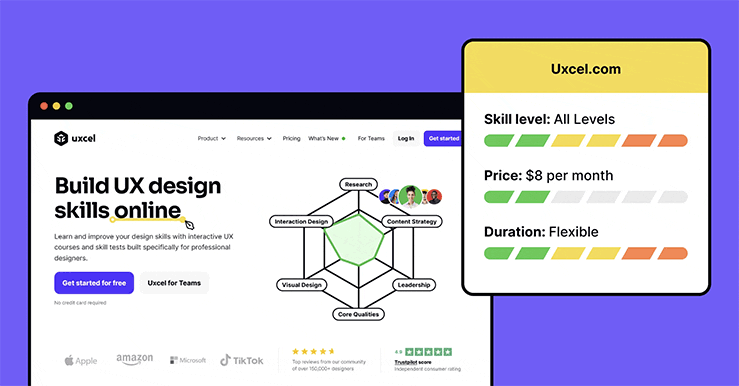
Article
6 Reasons Why UX research is Impacting Web Design Decisions
PUBLISHED:February 20, 2023
UPDATED:June 11, 2024
UX research sits at the core of the web design process, and every forward-thinking organization sees and understands the relevance of placing users at the centre of their design decisions.
Don’t get caught up in the common idea that a beautiful user interface is sufficient to ensure a good user experience. It’s a sheer fallacy!
Keep in mind that cyberspace ushers in around 252,000 new websites daily, each looking to address the pain points and grasp the attention of a targeted audience.
To stand out, 74% of businesses now leverage UX research as a masterpiece to boost conversion rates and keep their customers satisfied.
By conducting user research, you get to understand users on a whole new level through empathy and seeing things from their point of view, rather than basing your design decisions on guesswork and assumptions.
To fully grasp the concept of user research, this article promises an in-depth explanation of how influential UX research can be to your web design process.
The Thin Line Between UX and UX Research
You’re probably one of the many people who have a hard time differentiating UX research from UX in general. Albeit these two concepts are entirely intertwined, UX research is just one but the most vital of the six phases of the UX design process.
UX research is the bedrock of a good user experience, and all other phases of UX are dependent on it.
More reason UX designers are particularly keen on exploiting tools for UX research to understand
- the behaviour of users,
- their needs,
- their pain points,
- and ultimately allow the feedback to influence their design decisions to enhance the user experience.
To elucidate the contrast, UX, or user experience, refers to the behaviour of users when they interact with your product, while UX research is a pragmatic method of investigating users and garnering insights from them to inform the design process.
The Growing Demand for UX Researchers
There’s never been a better time to take on an online UX design course, especially now that the demand for UX designers is on the rise. The stats are jaw-dropping!
The US Bureau of Labor Statistics has predicted that jobs for UX designers will rise at an 8% rate, much more than average, indicating that organizations are beginning to see how impactful UX researchers can be to their businesses.
UX researchers come in handy
Conducting user research comes with many benefits but even though the risks are minimal, you can’t afford to take chances, mainly when the product being tested contains sensitive company information.
As a countermeasure, UX researchers do leverage the access request management approach to prevent unauthorized users from accessing and stealing their design concepts during usability testing.
The competition is fierce in the business world and your rivals will go the extra mile to stay ahead of the game even if it means spying on you. So, why not trust a UX researcher to keep them at bay?
With that said, let’s take a look at some key benefits of UX research and why they’re vital for your web design processes. Shall we?
Reasons Why UX Research Influences Web Decisions
1. Minimizes cost of development
Web design projects are a huge investment, but the introduction of proper UX research in your design process can help reduce development costs. Too bad some organizations still fail to accept this beautiful reality.
- A user-centred approach removes every element of bias from the design process.
- You tend to make data-driven decisions rather than working with assumptions.
- Usability testing is cost-effective and allows you to test various design concepts with real users with little or no risk.
- User research at the development stage also allows you to spot inconsistencies and areas which require improvements.
- All of these add up to protect your organization from incurring additional development costs and save a lot of resources that could have gone down the drain.
Besides, investing in UX research has proven to be a fail-safe way to boost customer retention and market shares.
2. Saves a lot of time
When you get the hang of the art of UX research, you’ll realize how handy it can be when it comes to time management. Many still misconstrue user research as a tedious process that takes a great deal of time and resources, but facts have proven otherwise.
The viability of your usability test can be deduced with as few as five to seven users, at times fewer, especially in cases of qualitative analysis. For the record, conducting a usability test with five users will identify 85% of the issues that are raised.
A smaller but similarly sized audience makes it easier to delve deeper into user motivations and experiences within a short space of time.
What counts most is your ability to carefully analyze the behaviour of users in each phase as they interact with your variables.
3. Generates more revenue
The main goal of any business is to keep making huge returns on investments, and your customers are the mother lode in this case.
When customers visit your site, make purchases, and complete tasks seamlessly, it gives them a sense of gratification. They become accustomed to your site, and that increases sales and conversion rates.
Websites with low usability rates end up frustrating customers, leading them to search for better services, and you don’t want that for your business.
When UX research is brought into play, you understand how users interact with your website and then exploit the insights you gain to boost their user experience. A better UX improves customer retention, and that yields more profit.
4. Levels up conversion rates
Don’t think too far!
You’re probably wondering how UX research influences conversion rates. Well, the reason isn’t far-fetched.
Conversion rates and revenues go pari passu since they are both dependent on customer activities, and a rise or fall in either affects the other.
To be more explicit, every organization strives to drive traffic to their sites, but what prompts visitors to stay and perform further tasks is a good user experience.
Conversion rate simply refers to the percentage of visitors who make a desired purchase on your site and well-strategized user research is proven to increase conversion rates by up to 400%.
The more visitors you have, the greater the chances of conversions. UX research allows you to craft smooth and intuitive design concepts that keep your customers engaged and naturally seduce new visitors.
5. Gives a competitive advantage
One of the most significant benefits of conducting user research is the competitive edge it provides. It’s the main reason why industry giants invest massively in user experience to stand tall in the ever-growing rivalry in the business world.
Keep in mind that we’re in an era of technologically savvy users who interact with various sites that offer similar services as you do. The implication is that customers will naturally go to your competitors if your site fails to fulfil their needs.
In the same vein, user research not only allows you to understand the needs of your customers, but you can also spy on your rivals and exploit their mistakes to your advantage.
- What do my customers like about my competitors?
- What do they like to buy from them?
- What are the expectations of users from my site?
- How do I revamp my competitor’s idea to win the heart of my customers?
These and many more are questions that good user research will help demystify.
6. Enhances customer loyalty and satisfaction
A user interface (UI)-based web design may successfully attract customers, but what keeps them coming back is a good user experience (UX). So, if you’re aiming to win the hearts of your users, you must first place yourself in their shoes.
UX research has different phases, and one of them is empathizing with users.
- When users have the impression that their opinions matter, it gives them a sense of belonging and they become affiliated with your site.
- Implementing the insights gained from user research helps you avoid complicated designs which can be frustrating to customers.
- Good UX research influences both the UI and UX of your design process and eventually translates to a user-friendly website.
- A user-friendly website enhances the overall user experience and generates more positive customer reviews.
In the long run, when customers become satisfied with your site, what you get is customer loyalty.
The value of user-centred design
And again, users must come first. The very essence of creating a website is to serve as a bridge between you and your customers, and it takes a great deal of time and brainstorming sessions to come up with a strategy that generates traffic and leads for your site.
So, why waste such effort on a web design that doesn’t align with your customers’ intent?
The benefits of UX research can’t be overemphasized until you tap into it and experience what you’ve been missing out on.
Thanks for reading, and I hope you leverage this piece as a means to up your game in the business world.
Rilwan Kazeem is a freelance content writer and an enthusiastic one at that. He has been in the writing world for three years. Being an explorer and reader, he engages his readers with in-depth and thought-provoking blogs and articles.
If you are interested in providing guest posts for our blog, please reference this article about guest blogging before getting in touch. Thank you.

